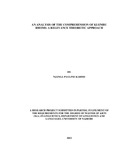| dc.description.abstract | This study offers an analysis of the comprehension of Ki-Embu idioms. The study
looks at how the hearer arrives at the figurative meaning of Ki-Embu idioms. The
significant fact about idioms is that its comprehension cannot rely on the
compositional meaning of the idiom. More contextual material has to be used to
understand idioms. So, different idioms like transparent, semi-transparent, semiopaque
and opaque idioms need different activation of contextual information. In
transparent idioms the hearer gets a clue from the words and can easily built the
metaphor. In the interpretation of semi-transparent idioms the hearer finds fewer
clues from words in the idioms and more activation of context is required. With
the comprehension of semi-opaque idioms the hearer can rely on minimal clues
from the actual words and more context is required. There is also need for cultural
references of some terms. For the comprehension of opaque idioms the hearer does
not get any clues from the words in the idioms. Opaque idioms are learnt like
concepts. The study uses Relevance Theory as a framework.
Chapter one provides the background of the study. It represents a brief description
of the language under study, the statement of the problem, the objectives,
significance of the study and the methodology used for data collection and
analysis. In chapter two the study has discussed general information on idioms, definition of
idioms and classification of idioms.Chapter three classifies the data that is the Ki-Embu idioms into the four categories discussed earlier. It also discusses the meanings of the idioms.
Chapter four discusses the application of the Relevance Theory in interpretation of
Ki-Embu idioms. It analyses the Ki-Embu idioms using the relevance theoretic
procedure and lexical pragmatics and specifically broadening.Finally, chapter five gives a brief summary of the study. | en |

